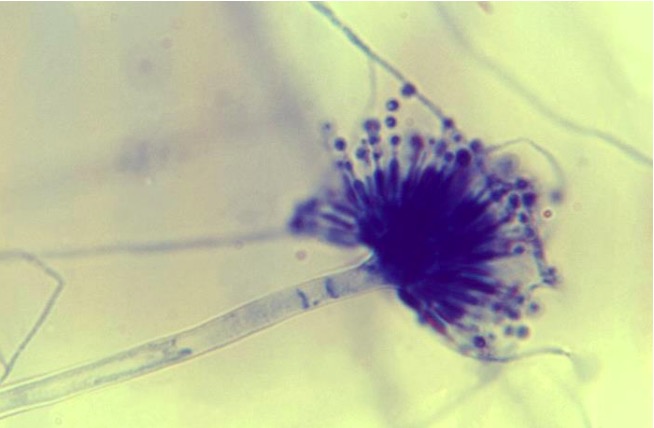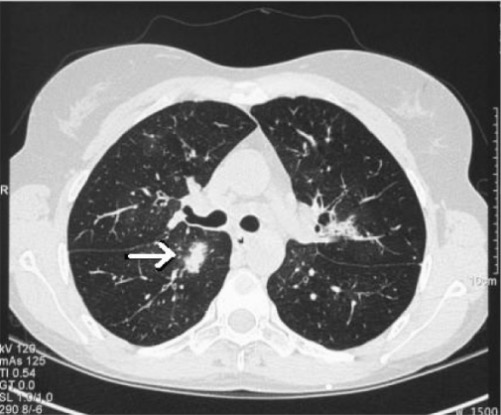Aspergillosis is an opportunistic fungal infection caused by Aspergillus Aspergillus A genus of mitosporic fungi containing about 100 species and eleven different teleomorphs in the family trichocomaceae. Echinocandins species, which are common spore-forming molds found in our environment. As Aspergillus Aspergillus A genus of mitosporic fungi containing about 100 species and eleven different teleomorphs in the family trichocomaceae. Echinocandins species are opportunistic, they cause disease primarily in patients Patients Individuals participating in the health care system for the purpose of receiving therapeutic, diagnostic, or preventive procedures. Clinician–Patient Relationship who are immunocompromised immunocompromised A human or animal whose immunologic mechanism is deficient because of an immunodeficiency disorder or other disease or as the result of the administration of immunosuppressive drugs or radiation. Gastroenteritis. The organs that are most commonly involved are the lungs Lungs Lungs are the main organs of the respiratory system. Lungs are paired viscera located in the thoracic cavity and are composed of spongy tissue. The primary function of the lungs is to oxygenate blood and eliminate CO2. Lungs: Anatomy and sinuses. Invasive aspergillosis can spread hematogenously and may involve the brain Brain The part of central nervous system that is contained within the skull (cranium). Arising from the neural tube, the embryonic brain is comprised of three major parts including prosencephalon (the forebrain); mesencephalon (the midbrain); and rhombencephalon (the hindbrain). The developed brain consists of cerebrum; cerebellum; and other structures in the brain stem. Nervous System: Anatomy, Structure, and Classification, heart, and skin Skin The skin, also referred to as the integumentary system, is the largest organ of the body. The skin is primarily composed of the epidermis (outer layer) and dermis (deep layer). The epidermis is primarily composed of keratinocytes that undergo rapid turnover, while the dermis contains dense layers of connective tissue. Skin: Structure and Functions. Symptoms may vary depending on the organ involved, but pulmonary symptoms may include shortness of breath Shortness of breath Dyspnea is the subjective sensation of breathing discomfort. Dyspnea is a normal manifestation of heavy physical or psychological exertion, but also may be caused by underlying conditions (both pulmonary and extrapulmonary). Dyspnea, wheezing Wheezing Wheezing is an abnormal breath sound characterized by a whistling noise that can be relatively high-pitched and shrill (more common) or coarse. Wheezing is produced by the movement of air through narrowed or compressed small (intrathoracic) airways. Wheezing, cough, and hemoptysis Hemoptysis Hemoptysis is defined as the expectoration of blood originating in the lower respiratory tract. Hemoptysis is a consequence of another disease process and can be classified as either life threatening or non-life threatening. Hemoptysis can result in significant morbidity and mortality due to both drowning (reduced gas exchange as the lungs fill with blood) and hemorrhagic shock. Hemoptysis. The diagnosis is made based on imaging studies, fungal cultures Fungal cultures Dermatophytes/Tinea Infections, and analysis of serologic or respiratory samples. Management depends on the presentation but can include antifungal Antifungal Azoles therapy and surgical resection in severe disease.
Last updated: Oct 31, 2022
Characteristics:
Morphology:

A Gomori methenamine silver (GMS) stain of Aspergillus showing uniform septate hyphae and branching at 45 degrees
Image: “GMS stain showing Aspergillus fungal hyphae” by Department of Medicine, Sinai Grace Hospital/Detroit Medical Center, Detroit, Michigan, USA. License: CC BY 2.0
Photomicrograph showing the branching hyphae of Aspergillus
Image: “15630” by CDC/Armed Forces Institute of Pathology (AFIP). License: Public Domain
Photomicrograph showing a slender Aspergillus conidiophore with a bulbous vesicle containing spherical conidia
Image: “19284” by CDC/Dr. Lucille K. Georg. License: Public DomainOver 250 species of Aspergillus Aspergillus A genus of mitosporic fungi containing about 100 species and eleven different teleomorphs in the family trichocomaceae. Echinocandins exist; however, only the following species are most commonly associated with aspergillosis:
Aspergillosis can have variable Variable Variables represent information about something that can change. The design of the measurement scales, or of the methods for obtaining information, will determine the data gathered and the characteristics of that data. As a result, a variable can be qualitative or quantitative, and may be further classified into subgroups. Types of Variables clinical presentations, with the most commonly involved organ systems being the lungs Lungs Lungs are the main organs of the respiratory system. Lungs are paired viscera located in the thoracic cavity and are composed of spongy tissue. The primary function of the lungs is to oxygenate blood and eliminate CO2. Lungs: Anatomy and skin Skin The skin, also referred to as the integumentary system, is the largest organ of the body. The skin is primarily composed of the epidermis (outer layer) and dermis (deep layer). The epidermis is primarily composed of keratinocytes that undergo rapid turnover, while the dermis contains dense layers of connective tissue. Skin: Structure and Functions. These disease presentations include:
Limited statistics are available on aspergillosis.
Humans inhale spores Spores The reproductive elements of lower organisms, such as bacteria; fungi; and cryptogamic plants. Anthrax daily, but generally do not develop the disease if they have a competent immune system Immune system The body’s defense mechanism against foreign organisms or substances and deviant native cells. It includes the humoral immune response and the cell-mediated response and consists of a complex of interrelated cellular, molecular, and genetic components. Primary Lymphatic Organs. Aspergillosis often occurs in people with underlying conditions such as:
The pathogenesis of each type of aspergillosis is not completely understood.
In immunocompetent patients Patients Individuals participating in the health care system for the purpose of receiving therapeutic, diagnostic, or preventive procedures. Clinician–Patient Relationship:
In immunocompromised immunocompromised A human or animal whose immunologic mechanism is deficient because of an immunodeficiency disorder or other disease or as the result of the administration of immunosuppressive drugs or radiation. Gastroenteritis patients Patients Individuals participating in the health care system for the purpose of receiving therapeutic, diagnostic, or preventive procedures. Clinician–Patient Relationship:
In patients Patients Individuals participating in the health care system for the purpose of receiving therapeutic, diagnostic, or preventive procedures. Clinician–Patient Relationship with underlying lung disease:
The clinical presentation varies based on the form of aspergillosis.
The following symptoms may be seen with any form of aspergillosis:
Allergic bronchopulmonary aspergillosis should be suspected in patients Patients Individuals participating in the health care system for the purpose of receiving therapeutic, diagnostic, or preventive procedures. Clinician–Patient Relationship with asthma Asthma Asthma is a chronic inflammatory respiratory condition characterized by bronchial hyperresponsiveness and airflow obstruction. The disease is believed to result from the complex interaction of host and environmental factors that increase disease predisposition, with inflammation causing symptoms and structural changes. Patients typically present with wheezing, cough, and dyspnea. Asthma or cystic Cystic Fibrocystic Change fibrosis Fibrosis Any pathological condition where fibrous connective tissue invades any organ, usually as a consequence of inflammation or other injury. Bronchiolitis Obliterans who present with recurrent exacerbations. Symptoms include:
Aspergillus Aspergillus A genus of mitosporic fungi containing about 100 species and eleven different teleomorphs in the family trichocomaceae. Echinocandins sinusitis Sinusitis Sinusitis refers to inflammation of the mucosal lining of the paranasal sinuses. The condition usually occurs concurrently with inflammation of the nasal mucosa (rhinitis), a condition known as rhinosinusitis. Acute sinusitis is due to an upper respiratory infection caused by a viral, bacterial, or fungal agent. Sinusitis may be allergic or invasive. Symptoms include:
Some patients Patients Individuals participating in the health care system for the purpose of receiving therapeutic, diagnostic, or preventive procedures. Clinician–Patient Relationship with chronic pulmonary aspergillosis and aspergilloma are asymptomatic. Symptomatic individuals may present with:
Pulmonary:
Disseminated infection:
Cutaneous aspergillosis may occur from direct inoculation or disseminated infection. Patients Patients Individuals participating in the health care system for the purpose of receiving therapeutic, diagnostic, or preventive procedures. Clinician–Patient Relationship may present with:
Chest imaging with X-ray X-ray Penetrating electromagnetic radiation emitted when the inner orbital electrons of an atom are excited and release radiant energy. X-ray wavelengths range from 1 pm to 10 nm. Hard x-rays are the higher energy, shorter wavelength x-rays. Soft x-rays or grenz rays are less energetic and longer in wavelength. The short wavelength end of the x-ray spectrum overlaps the gamma rays wavelength range. The distinction between gamma rays and x-rays is based on their radiation source. Pulmonary Function Tests or CT are commonly ordered. Findings may include:

Computed tomography images demonstrating bronchiectasis in the right middle lobe (C) and left lower lobe (A and B) due to allergic bronchopulmonary aspergillosis
Image: “Bronchopulmonary aspergillosis” by Department of Respiratory Medicine, Hammersmith Hospital, London, UK. License: CC BY 4.0
Chest X-ray and CT images demonstrating an aspergilloma in a patient with cystic fibrosis:
The fungus ball is located in the left upper lobe, where a previous cavity was present. A crescent of air can be seen within the cavity on CT (“air crescent sign”).

A CT demonstrating a “halo sign” indicative of hemorrhage due to angioinvasion of aspergillosis
Image: “Halo sign” by Faculty of Medicine and Human Sciences, University of Manchester, Wythenshawe Hospital, Manchester, UK. License: CC BY 2.0The following options may be used in invasive disease, including invasive sinusitis Sinusitis Sinusitis refers to inflammation of the mucosal lining of the paranasal sinuses. The condition usually occurs concurrently with inflammation of the nasal mucosa (rhinitis), a condition known as rhinosinusitis. Acute sinusitis is due to an upper respiratory infection caused by a viral, bacterial, or fungal agent. Sinusitis, cutaneous disease, and disseminated disease: